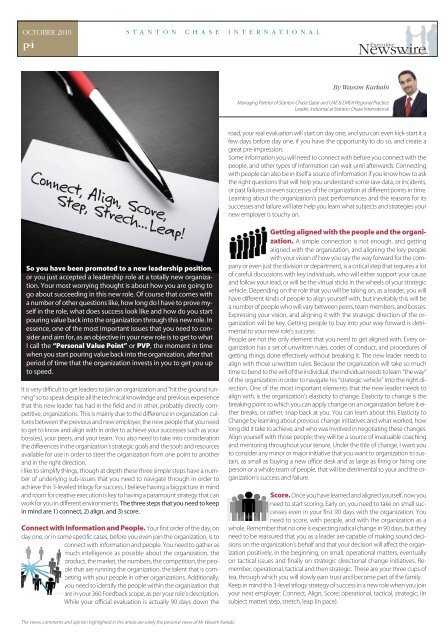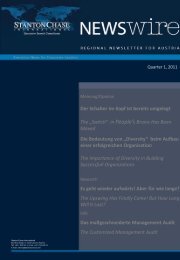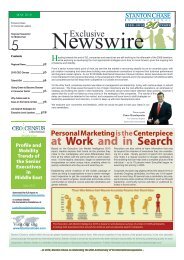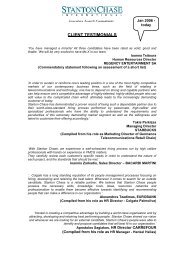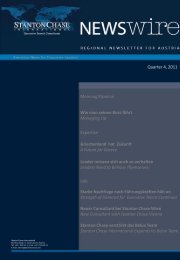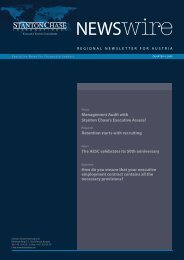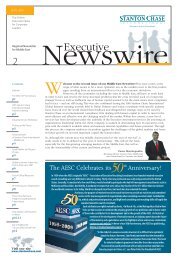WORLD ECONOMY - Stanton Chase
WORLD ECONOMY - Stanton Chase
WORLD ECONOMY - Stanton Chase
You also want an ePaper? Increase the reach of your titles
YUMPU automatically turns print PDFs into web optimized ePapers that Google loves.
OCTOBER 2010<br />
p4<br />
Connect, Align, Score,<br />
Step, Strech...Leap!<br />
So you have been promoted to a new leadership position,<br />
or you just accepted a leadership role at a totally new organization.<br />
Your most worrying thought is about how you are going to<br />
go about succeeding in this new role. Of course that comes with<br />
a number of other questions like, how long do I have to prove myself<br />
in the role, what does success look like and how do you start<br />
pouring value back into the organization through this new role. In<br />
essence, one of the most important issues that you need to consider<br />
and aim for, as an objective in your new role is to get to what<br />
I call the “Personal Value Point” or PVP, the moment in time<br />
when you start pouring value back into the organization, after that<br />
period of time that the organization invests in you to get you up<br />
to speed.<br />
It is very difficult to get leaders to join an organization and “hit the ground running”<br />
so to speak despite all the technical knowledge and previous experience<br />
that this new leader has had in the field and in other, probably directly competitive,<br />
organizations. This is mainly due to the difference in organization cultures<br />
between the previous and new employer, the new people that you need<br />
to get to know and align with in order to achieve your successes such as your<br />
boss(es), your peers, and your team. You also need to take into consideration<br />
the differences in the organization’s strategic goals and the tools and resources<br />
available for use in order to steer the organization from one point to another<br />
and in the right direction.<br />
I like to simplify things, though at depth these three simple steps have a number<br />
of underlying sub-issues that you need to navigate through in order to<br />
achieve this 3-leveled trilogy for success, I believe having a big picture in mind<br />
and room for creative execution is key to having a paramount strategy that can<br />
work for you in different environments. The three steps that you need to keep<br />
in mind are 1) connect, 2) align, and 3) score.<br />
Connect with Informationand People. Your first order of the day, on<br />
day one, or in some specific cases, before you even join the organization, is to<br />
connect with information and people. You need to gather as<br />
much intelligence as possible about the organization, the<br />
product, the market, the numbers, the competition, the people<br />
that are running the organization, the talent that is competing<br />
with your people in other organizations. Additionally,<br />
you need to identify the people within the organization that<br />
are in your 360 Feedback scope, as per your role’s description.<br />
While your official evaluation is actually 90 days down the<br />
S T A N T O N C H A S E I N T E R N A T I O N A L<br />
The views, comments and opinion highlighted in this article are solely the personal views of Mr Wassim Karkabi.<br />
Executive<br />
Newswire<br />
By Wassim Karkabi<br />
Managing Partner of <strong>Stanton</strong> <strong>Chase</strong> Qatar and UAE & EMEA Regional Practice<br />
Leader, Industrial at <strong>Stanton</strong> <strong>Chase</strong> International<br />
road, your real evaluation will start on day one, and you can even kick-start it a<br />
few days before day one, if you have the opportunity to do so, and create a<br />
great pre-impression.<br />
Some information you will need to connect with before you connect with the<br />
people, and other types of information can wait until afterwards. Connecting<br />
with people can also be in itself a source of information if you know how to ask<br />
the right questions that will help you understand some raw data, or incidents,<br />
or past failures or even successes of the organization at different points in time.<br />
Learning about the organization’s past performances and the reasons for its<br />
successes and failure will later help you learn what subjects and strategies your<br />
new employer is touchy on.<br />
Getting aligned with the people and the organization.<br />
A simple connection is not enough, and getting<br />
aligned with the organization, and aligning the key people<br />
with your vision of how you say the way forward for the company<br />
or even just the division or department, is a critical step that requires a lot<br />
of careful discussions with key individuals, who will either support your cause<br />
and follow your lead, or will be the virtual sticks in the wheels of your strategic<br />
vehicle. Depending on the role that you will be taking on, as a leader, you will<br />
have different kinds of people to align yourself with, but inevitably this will be<br />
a number of people who will vary between peers, team members, and bosses.<br />
Expressing your vision, and aligning it with the strategic direction of the organization<br />
will be key. Getting people to buy into your way forward is detrimental<br />
to your new role’s success.<br />
People are not the only element that you need to get aligned with. Every organization<br />
has a set of unwritten rules, codes of conduct, and procedures of<br />
getting things done effectively without breaking it. The new leader needs to<br />
align with those unwritten rules. Because the organization will take so much<br />
time to bend to the will of the individual, the individual needs to learn “the way”<br />
of the organization in order to navigate his “strategic vehicle” into the right direction.<br />
One of the most important elements that the new leader needs to<br />
align with, is the organization’s elasticity to change. Elasticity to change is the<br />
breaking point to which you can apply change on an organization before it either<br />
breaks, or rather, snap back at you. You can learn about this Elasticity to<br />
Change by learning about previous change initiatives and what worked, how<br />
long did it take to achieve, and who was involved in negotiating these changes.<br />
Align yourself with those people; they will be a source of invaluable coaching<br />
and mentoring throughout your tenure. Under the title of change, I want you<br />
to consider any minor or major initiative that you want to organization to sustain,<br />
as small as buying a new office desk and as large as firing or hiring one<br />
person or a whole team of people, that will be detrimental to your and the organization’s<br />
success and failure.<br />
Score. Once you have learned and aligned yourself, now you<br />
need to start scoring. Early on, you need to take on small successes<br />
even in your first 90 days with the organization. You<br />
need to score, with people, and with the organization as a<br />
whole. Remember that no one is expecting radical change in 90 days, but they<br />
need to be reassured that you as a leader are capable of making sound decisions<br />
on the organization’s behalf and that your decision will affect the organization<br />
positively, in the beginning, on small, operational matters, eventually<br />
on tactical issues and finally on strategic directional change initiatives. Remember,<br />
operational, tactical and then strategic. These are your three cups of<br />
tea, through which you will slowly earn trust and become part of the family.<br />
Keep in mind this 3-level trilogy strategy of success in a new role when you join<br />
your next employer: Connect, Align, Score; operational, tactical, strategic; (in<br />
subject matter) step, stretch, leap (in pace).


